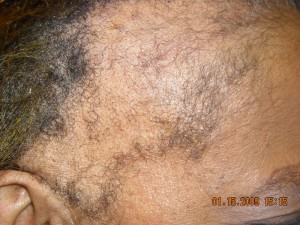Traction Alopecia
Candrice R. Heath, MD, Caroline N. Robinson, BS and Roopal V. Kundu, MD
 Traction alopecia is a form of hair loss in which mechanical damage to the hair follicle is caused by repeated tension or pulling. This type of hair loss is common among people with skin of color, especially African-American women, although it may be seen among all ethnic groups and ages. Ballerinas, gymnasts, military personnel and certain professionals who are required to wear their hair pulled back, may develop traction alopecia.
Traction alopecia is a form of hair loss in which mechanical damage to the hair follicle is caused by repeated tension or pulling. This type of hair loss is common among people with skin of color, especially African-American women, although it may be seen among all ethnic groups and ages. Ballerinas, gymnasts, military personnel and certain professionals who are required to wear their hair pulled back, may develop traction alopecia.
What is the cause of traction alopecia?
Traction alopecia can be caused by wearing the same hairstyle for long periods of time, especially those that tug on the hair (e.g., braids, weaves, cornrows, tight pony-tails, heavy locks, hair rollers, etc). Tight hairstyles applied to relaxed hair can lead to even further damage.1 The constant pulling on the hair causes loosening of the hair from the follicles.2 Sometimes associated symptoms on the scalp can been seen including bumps, redness and tenderness. The prolonged inflammation and repeated hair tension may lead to gradual hair loss and scarring of the hair follicles.
How do I know if I have traction alopecia?
Early on, you may notice small flesh colored or white bumps around hair follicles where the hair is pulled most tightly.3 Shortly thereafter, symmetric hair loss appears. The hair loss is usually most noticeable around the hairline. So called baby (vellus) hairs are spared and broken hairs are often present throughout the area of hair loss.2 Initially, traction alopecia is temporary, but if hairstyling habits are unchanged, the hair loss may become permanent.
What treatments are available for traction alopecia?
In the early stages, the best treatment for traction alopecia is to limit or eliminate any hairstyles that pull on the hair and to wear hair in loose styles (especially overnight).4 Reducing the amount of chemicals and heat used during styling is recommeneded.1 The presence of scalp tenderness, bumps or inflammation may be treated with topical antibiotics or topical corticosteroids. For moderate to severe traction alopecia, more aggressive treatments such as oral antibiotics, injected corticosteroids or topical minoxidil may be necessary.3 Once scarring is present, hair transplantation may be one of the few available options.1 The best treatment of traction alopecia is prevention.
Download Spanish translation.
Descarga traducción en español.
Additional Resources
Cicatricial Alopecia Research Foundation
References
1. Haskin A1, Aguh C2. All hairstyles are not created equal: What the dermatologist needs to know about black hairstyling practices and the risk of traction alopecia (TA). J Am Acad Dermatol. 2016 [Epub ahead of print].
2. Callendar VD and Young CM. Alopecias and hair restoration in women. In: Aesthetics
and Cosmetic Surgery for Darker Skin Types. Philadelphia: Lippincott Williams and
Wilkins; 2008. P. 287‐295.
3. Quinn, CR. Alopecia. In: Kelly AP, Taylor SC, editors. Dermatology for Skin of Color.
New York: McGraw Hill Medical; 2009. p.227‐239.
4. Quinn, CR. Hair Care Practices. In: Kelly AP, Taylor SC, editors. Dermatology for Skin
of Color. New York: McGraw Hill Medical; 2009. p.217‐226.

Cutis Journal
Read published peer-reviewed articles written your by Skin of Color Society members

Did You Know
Skin of color patients comprise the majority in California, New Mexico and Texas…and soon will be the majority in Arizona, Nevada, Georgia, New York and Florida.
By 2042, more than 50% of the US population will have skin of color.




